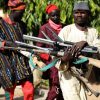The Omicron variant as caused a lot of damages to the economic sector and governments are tempted to shut down schools to reduce the infection rate in the country. The World Bank has said, that the new wave of COVID-19 pandemic has seen a variant of the virus, Omicron, ravaging the world. Omicron variant and
The Omicron variant as caused a lot of damages to the economic sector and governments are tempted to shut down schools to reduce the infection rate in the country. The World Bank has said, that the new wave of COVID-19 pandemic has seen a variant of the virus, Omicron, ravaging the world.
Omicron variant and the effect on schools.
In the said report, the bank also said no fewer than 647 million schoolchildren are yet to fully resume either physical or online learning. Adding that school children in developing nations are the hardest hit regarding the negative effects the pandemic has had on education globally.
“When schools around the world moved online due to COVID-19, children in developing countries suffered the most.
“Even though digital learning does not produce the same outcomes as in-person education, technology used effectively can close educational gaps and prevent learning loss. “As the third year of the COVID-19 pandemic approaches, classrooms remain fully or partially closed for as many as 647 million schoolchildren around the world.
“Even where schools have reopened, many students continue to lag behind. It is now abundantly and painfully clear that children have learned less during the pandemic.”
According to World Bank estimates, pandemic-related school closures could drive up “learning poverty” – the share of 10-year-olds who cannot read a basic text – to around 70% in low- and middle-income countries.
This learning loss could cost an entire generation of schoolchildren $17 trillion in lifetime earnings.
“As the Omicron variant takes hold, more governments may be tempted to close schools. Without the online infrastructure in place to support learning, doing so would extend the educational losses and deny children many other benefits of daily school attendance, like the possibility to connect with classmates and develop social skills for personal growth.
Interactions with teachers and peers are essential to develop the abilities necessary to work collaboratively. Being part of a class promotes a sense of belonging and helps build self-esteem and empathy.
Throughout the pandemic, marginalized children have struggled the most. When classrooms around the world reopened this fall, it became clear that these children had fallen even further behind their peers.
Before the pandemic, gender parity in education was improving. But school closures placed an estimated 10 million more girls at risk of early marriage, which practically guarantees the end of their schooling.
Unless this regression is reversed, learning poverty and the associated human capital loss will hold economies and societies back for decades. Children must be given a chance to recover the education they have lost.
They need access to well-designed reading materials, digital learning opportunities, and transformed education systems that help prepare them for future challenges. Well qualified teachers and effective use of technology are fundamental to this process.
Many countries have deployed massive stimulus packages in response to the health crisis. But, as of June 2021, less than three per cent of these funds was devoted to the education and training sector.
And most of these resources were spent in advanced economies. For many low-income countries, elevated debt-service payments crowd out essential social spending – including for education.
The resulting weakness in investments to support education and training threatens to deepen the disparities in learning outcomes that existed prior to the pandemic.
And while narrowing the education gap will require using resources more efficiently, the bottom line is that more resources are needed.
For the world’s poorest countries, in particular, an acceleration in debt relief under the G20’s Common Framework, would provide fiscal space to increase support for human capital.
Investment in education must include funding for educational technology, taking into account what has worked well in different contexts around the world,” the report said.
The Bank stressed further on the need to improve investment in infrastructure to move education to the digital level and commended countries such as Uruguay and India for making giant strides in that direction.“By investing in learning recovery and using technology wisely, it is possible to use the pandemic experience as a catalyst to improve education for all children.
The United Nations Children’s Fund (UNICEF) and the World Bank Group are working together to ensure that all education systems use technology effectively to close gaps and help reverse learning losses.
Embedding the use of technology within an overall strategy for ending learning poverty can help improve foundational skills, increase instructional time, and make the most efficient use of resources.
This is particularly critical in low-income countries, where technology can provide teachers with the support they need quickly.
Digital access can serve as a great equalizer. Resources must be invested wisely, taking into account countries’ electricity infrastructure, internet connectivity, digitally enabled devices for the most disadvantaged students, and data-management and implementation capacity.
Without a carefully considered process to increase the use of technology, good intentions and well-designed policies will fail to achieve the recovery and acceleration of learning that developing countries need.
By investing in learning recovery and using technology wisely, it is possible to use the pandemic experience as a catalyst to improve education for all children,” the report added.
“The World Bank is an institution that was established in 1944 and since 1958 has provided Nigeria with low interest rate loans and grants through the International Development Association (IDA) and International Bank for Reconstruction and Development (IBRD).As of 2018, it consists of 189 member countries.
Its primary goal was to help and rebuild countries after the World War 2. But now, its goal is to eradicate poverty in every member country. After her independence in 1960, Nigeria officially joined the World Bank on March 30, 1961. As the World Bank’s goals and outreach in different countries have diversified, they have gradually over the years organized the bank into five agencies to tackle specific issues in low and middle-income countries. Since then, Nigeria has partnered up with the IDA, specifically built to help low-income countries and give out loans for very low interest rates, and the IBRD”. This section is culled from WIKIPEDIA.


















Leave a Comment
Your email address will not be published. Required fields are marked with *